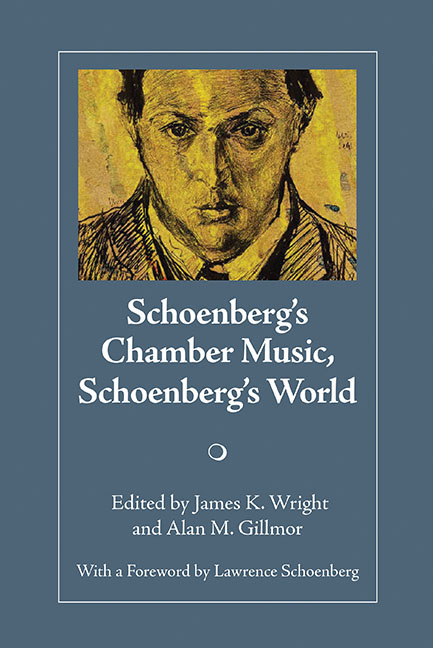Book contents
- Frontmatter
- Contents
- Foreword
- Preface
- HISTORICAL PERSPECTIVES
- ANALYTICAL PERSPECTIVES
- Schoenberg as Webern: The Three Pieces for Chamber Orchestra, III (1910)
- Juxtaposing Popular Music in the Second String Quartet, Op. 10
- A Chronology of Intros, an Enthrallogy of Codas: The Case of Schoenberg's Chamber Symphony, Op. 9
- Schoenberg's First Chamber Symphony, Formalism, and Adorno's Critique of Twelve-Tone Composition
- Precedents of Schoenberg's Compositional Practice in the Chamber Works of Joseph Haydn
- OTTAWA SYMPOSIUM AND CHAMBER MUSIC FESTIVAL PHOTOS
- PERFORMANCE, RECEPTION, AND INTERNATIONAL INFLUENCE
A Chronology of Intros, an Enthrallogy of Codas: The Case of Schoenberg's Chamber Symphony, Op. 9
from ANALYTICAL PERSPECTIVES
- Frontmatter
- Contents
- Foreword
- Preface
- HISTORICAL PERSPECTIVES
- ANALYTICAL PERSPECTIVES
- Schoenberg as Webern: The Three Pieces for Chamber Orchestra, III (1910)
- Juxtaposing Popular Music in the Second String Quartet, Op. 10
- A Chronology of Intros, an Enthrallogy of Codas: The Case of Schoenberg's Chamber Symphony, Op. 9
- Schoenberg's First Chamber Symphony, Formalism, and Adorno's Critique of Twelve-Tone Composition
- Precedents of Schoenberg's Compositional Practice in the Chamber Works of Joseph Haydn
- OTTAWA SYMPOSIUM AND CHAMBER MUSIC FESTIVAL PHOTOS
- PERFORMANCE, RECEPTION, AND INTERNATIONAL INFLUENCE
Summary
In the twilight zone of fin-de-siècle tonality, composers faced new challenges in finding the right vocabulary and syntax with which to begin and end works. How does one convincingly construct the affirmation of tonality within a work when tonality itself is systemically disintegrating around it? How does one compellingly assemble the thematic components of a work in the changed form-functional environment of extended tonal or atonal pitch relations? Through a “chronology of intros” I briefly review a variety of exemplary opening gambits in selected symphonic works by Bruckner, Strauss, Mahler, Debussy, Schoenberg, and Berg. Similarly, the challenge of balancing strategies for peroration or dissipation in closure leads through a parallel consideration of what has been aptly termed an “enthrallogy of codas.” In the case of Schoenberg's Chamber Symphony, a chamber work in richly symphonic guise, the renowned introductory quartal gesture and subsequent thematic materials set up their own chronology of form-functional expectation. And the closing sections of the first movement exposition and the work as a whole create their own enthrallogy of ecstasy-inducing codas.
Enthrallogy, Chronology, Bangs and Whimpers
Beginning with the end in mind, let us first examine the “Enthrallogy of Codas” shown in Figure 1. This list, as well as the neologism itself, was first introduced to me by Robert Falck in a seminar on Impressionism and Expressionism at the University of Toronto in the late 1970s. Falck's selections might easily be augmented of course, and many of us will have our own favorites both on and off his list. But his “enthrallogy” provides an idiosyncratic yet intriguing anthology of Austro-German and French repertoire (with one Puccini example for operatic good measure). Each work or movement on the list— whether orchestral, chamber, or solo keyboard—possesses a particularly beautiful, awesome, enthralling, transfiguring, splendid close.
I will not elaborate further on Falck's list in this paper. Rather, with apologies to T. S. Eliot, I will ask: “Which is the way tonality ends? With a bang or with a whimper?” That is, a work or movement may invoke a tonal closure that is compelling, affirming, ecstatic, and anti-entropic. Alternatively, it may seek an end that is dissipating, resigned, cathartic, that winds-up only to wind-down. The same options obtain in the introductions of works: they may “start with a bang,” or find their way forth gradually.
- Type
- Chapter
- Information
- Schoenberg's Chamber Music, Schoenberg's World , pp. 97 - 132Publisher: Boydell & BrewerPrint publication year: 2009



